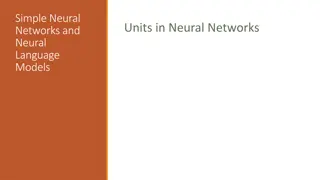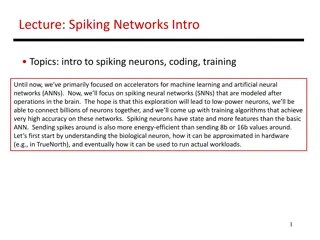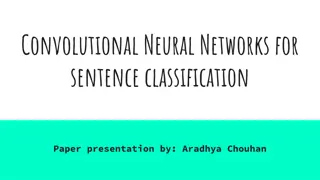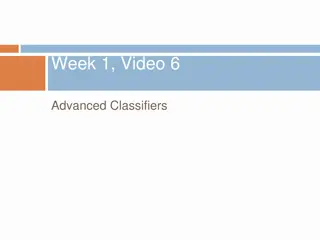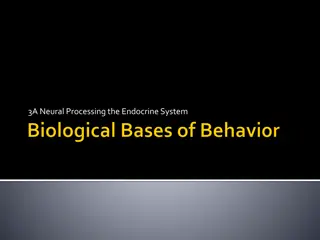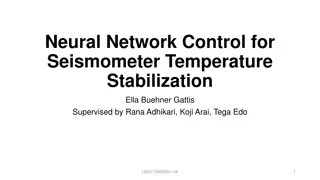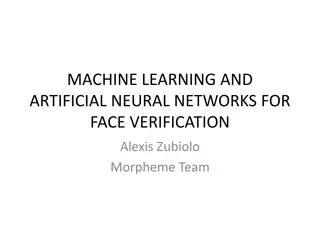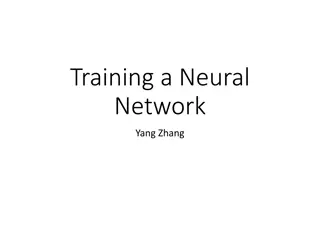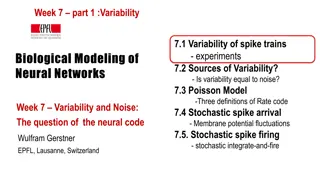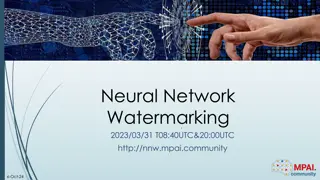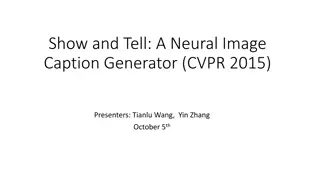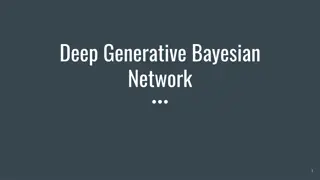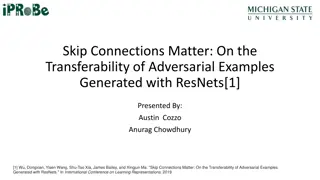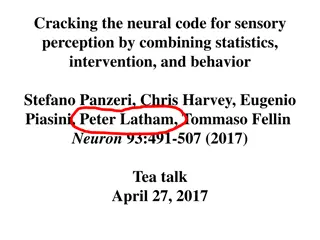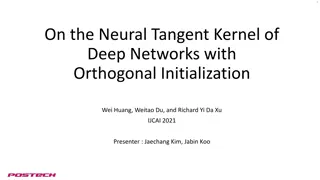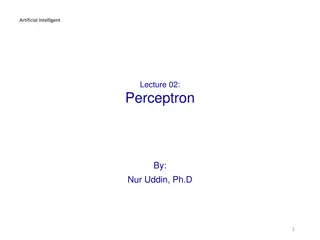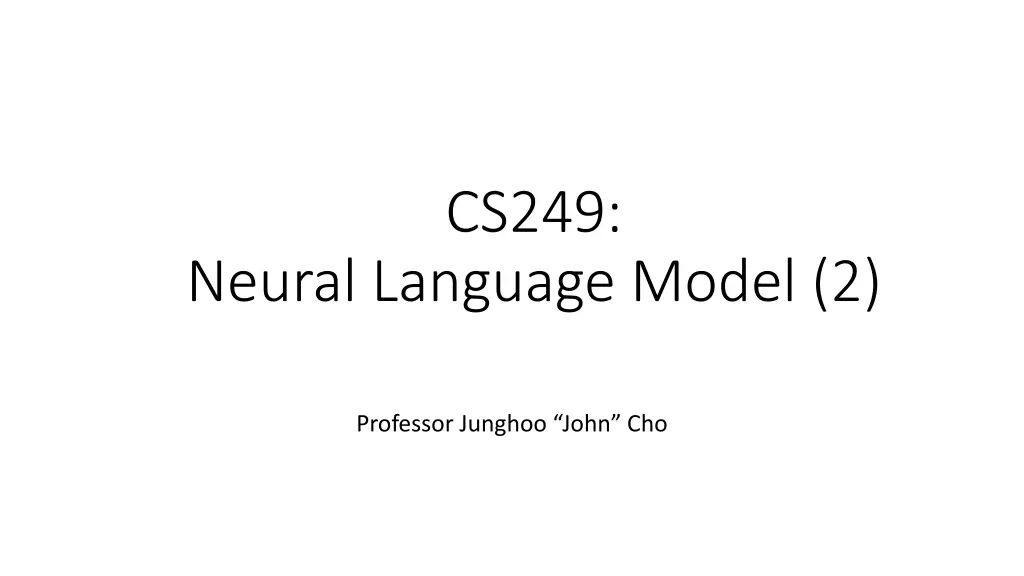
Neural Language Model Overview
Explore the concepts in neural language modeling with insights from Professor Junghoo John Cho and discussions on word embeddings, training data, and mathematical formulations. Discover how neural networks are used to learn word-to-vector mappings for language representation.
Download Presentation

Please find below an Image/Link to download the presentation.
The content on the website is provided AS IS for your information and personal use only. It may not be sold, licensed, or shared on other websites without obtaining consent from the author. If you encounter any issues during the download, it is possible that the publisher has removed the file from their server.
You are allowed to download the files provided on this website for personal or commercial use, subject to the condition that they are used lawfully. All files are the property of their respective owners.
The content on the website is provided AS IS for your information and personal use only. It may not be sold, licensed, or shared on other websites without obtaining consent from the author.
E N D
Presentation Transcript
CS249: Neural Language Model (2) Professor Junghoo John Cho
Todays Topics More on neural language model Yoshua Bengio, et al.: A Neural Probabilistic Language Model From neural language model to word embedding Tomas Mikolov, et al.: Efficient Estimation of Word Representations in Vector Space Tomas Mikolov, et al.: Distributed Representations of Words and Phrases and their Compositionality
Machine Learning Machine learning requires Training data: ?1, ?1, ?2, ?2, ,( ??, ??) Choice of parameterized function (hypothesis space): ??( ?) Loss function Optimization technique
[Bengio 2003] What is the Problem? Build a good language model Learn ? ???1 ?? 1 from training data Challenge: We want to get reasonable ? ???1 ?? 1 even for an unseen word sequence Curse of dimensionality Q: How can we estimate ? ???1 ?? 1 when we haven t seen them?
[Bengio 2003] How? Key Intuition? Paradigmatic relationship cat , dog , : words that often appear in similar context A good language model should be ? ????? ??? ?(?????|???) Build a language model so that the conditional probability is similar for similar words! Q: How can we formalize this intuition as a mathematical model?
[Bengio 2003] Mathematical Formulation? Map each word ??to a vector ??, so that the vectors ??and ??are close to each other when the words ??and ??are similar Represent ? ???1 ?? 1 = ??(?1, ,?? 1) as a function of the input word vectors, ???1, ,?? 1 Intuition: When similar words ?? ??are mapped to similar vectors ?? ??, then ??(??, ,?? 1) ??(??, ,?? 1) As long as ??is a smooth function Q: How to learn ??and ???1, ,?? 1?
[Bengio 2003] How to Learn ??and ?() ? Jointly learn them by building and training a neural network ?1 ?2 ?1 ?2 0.03 0.01 0.05 ? ?? ??
Word to Vector Mapping 1-hot encoding : Represent ??as a (0-1) vector of V dimension V: vocabulary size The vector has 1 only at the ith dimension. All others are zero Embedding matrix W | | ?1 ?2 | | | ith column has the vector embedding ?? of word ?? Mapping of ?? ?? ?? can be seen as a matrix multiplication 0 1 0 | ? = ?? | | | | ?? | ?? | ?1 | ?2 | =
[Bengio 2003] ?(?1??) ?1 ?2 ?1 ?2 0.03 0.01 0.05 ? ?? ??
[Bengio 2003] ?(?1??) ?1 ?1 W 0.03 0.01 0.05 [m] . . . [V] ? ?? ?? [m] [V]
[Bengio 2003] ?(?1??) ?1 ?1 Q: Trainable parameters of the network? W ? H 0.03 0.01 0.05 U [m] . . . . . . [V] tanh softmax ?? ?? [V] [h] ?? ? ? ??+ ? ? ??? ???? tanh ? = softmax ?? = [m] [V]
[Bengio 2003] Loss Function? Maximum likelihood Pick the parameters so that the probability of the training data is highest Q: What is the probability of the training data? Given sequence ?1 ??, the probability of next word ??+1 is ? ??+1?1 ?? = ??+1?1, ,?? Maximize the probability of the entire word sequence of the training corpus ??+1?1, ,????+2?2, ,??+1 ???? ?, ,?? 1 Compute the sum of log probability log???? ? ?? 1 for every word sequence in training data and maximize the sum! Q: How to maximize?
[Bengio 2003] Optimization Technique? Q: What technique is used to solve the optimization problem? A: 1. Use back-propagation algorithm with SGD to maximize the log-likelihood of the training data 2. Some discussion on parallel implementation of the back-propagation algorithm to speed up the learning process, but this is not very relevant today due to the use of GPU-based optimizations
[Bengio 2003]: Result Trained and evaluated the result on Brown and AP News corpus using perplexity metric (geometric mean of probabilities) Obtained state-of-the-art result on 15 million word input data in terms of perplexity 10-20% better than smoothed trigram model
Neural Language Model of [Mikolov 2010, 2011a, 2011b] Follow-up work to [Bengio 2003] on neural language models Main question: Fixing the context length ? is in advance seems ad hoc. Can we avoid it? A: Use Recurrent Neural Network (RNN) Recurrent structure allows looking at longer context in principle Simple structure makes training more scalable
?(?1,, ??) of [Mikolov 2010, 2011a, 2011b] ?(?) ?(?) = ??(?) ?(?) (?) = sigmoid(? ? + ? ? 1 ) ?(?) = ? (?) ?(?) = softmax(?(?)) ?(?) W (?) [m] V softmax sigmoid + (? 1) [V] U [m] ??? ???? 1 sigmoid ? = softmax ?? = 1 + ? ? [V] [m]
Loss Function of [Mikolov 2010] ??(?) = |??? ??? | Paper says ??(?) = ??? ??? , but that is unlikely Backpropagate sum of ??(?) s for multiple training instances using SGD Dealing with rare words All rare words that appear less than a threshold value are mapped to the same rare word token Significantly reduces the dimension of input/output vector and model complexity
Result of [Mikolov 2010, 2011a, 2011b] Perplexity (geometric mean of likelihood) and WER (word error rate) are measured against standard speech recognition dataset (DARPA WSJ) About 50% improvement in perplexity and 10%-18% improvement in WER But more importantly, in his next paper, Mikolov wondered, does the vector ? mean anything? Does it in any way capture some semantic meaning of words? What does distance between two word vectors represent, for example?
Observation in [Mikolov 2013a] The difference between ?1 and ?2 captures the syntactic/semantic relationship between the two words!
Vector Difference Captures Relationship ?(king) - ?(man) + ?(woman) = ?(queen)!!! woman queen man king Experimental result Trained RNN with m = 1600 on 320M words Broadcast News data 40% accuracy on syntactic relationship test (good:better bad:worse) First result showing that word vectors mean something much more than what had been expected
Many Questions Why does it work???? Why do these vectors capture semantics? Is the result due to the particular choice of the neural network, RNN? Shall we get better results if much larger dataset is used?
Follow Up: [Mikolov 2013b] Questions Is the result due to the particular choice of the neural network, RNN? Shall we get better results if much larger dataset is used? Q: How should we investigate these questions? [Mikolov 2013b] Trained word vectors using significantly simplified neural network models Continuous Bag Of Words (CBOW) model Continuous Skip-Gram model Simpler models allowed significant reduction in training time. Allows training on much larger dataset
CBOW Model: ? ? ?1,,?? ?1 ?1 ?(?) = ??(?) = (? ? + ?? ? 1 ) ?(?) = ??(?) ?(?) = softmax(?(?)) Much simpler model Given ? context words, predict the next word W ? [m] . . . W [V] softmax + ?? ?? [m] [V] [m] [V]
Skip-Gram Model: ? ?? ? = ?? ? = ? ? ? ?(?) = softmax(?(?)) Significantly simpler model Not even addition of multiple context vectors Given a word, predict ? context words Inverse prediction For every word, ? training data instance is generated W W softmax [m] [V] [V]
Result of [Mikolov 2013b] In general, Skip-Gram model performs best Much better than his earlier model Better than CBOW on average The same vector-difference relationship holds What does it mean? The vector-difference result was not because of the particular choice of the neural network and/or loss function Using more data makes things better Probably the reason why Skip-Gram performs better than CBOW But still, why does it work in the first place? What is the reason behind this magical result?



